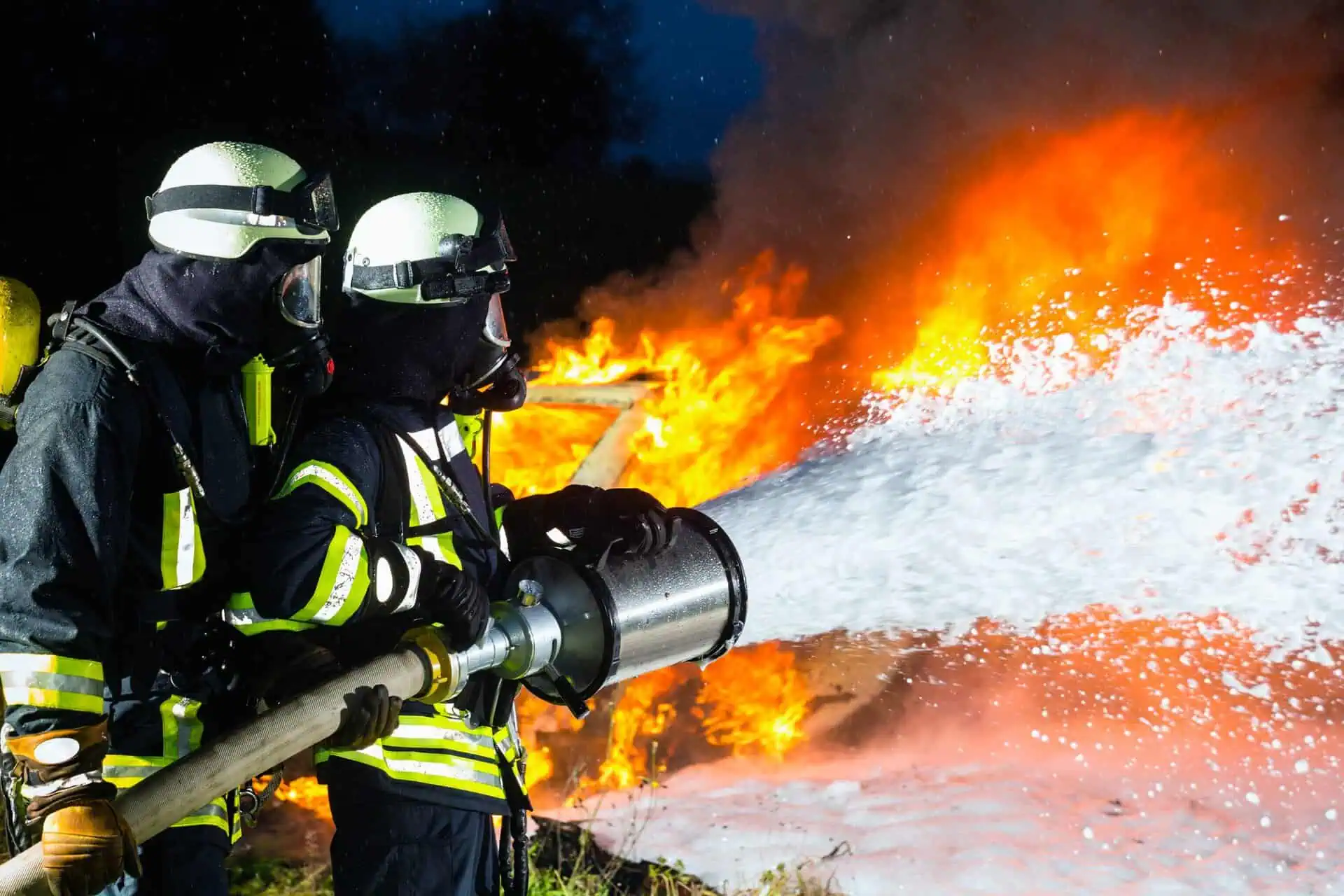AFFF Exposure Symptoms: Firefighting Foam Linked to Cancer
- Last Updated: June 12th, 2025

Attorney Jessica Paluch-Hoerman, founder of TruLaw, has over 28 years of experience as a personal injury and mass tort attorney, and previously worked as an international tax attorney at Deloitte. Jessie collaborates with attorneys nationwide — enabling her to share reliable, up-to-date legal information with our readers.
Legally Reviewed
This article has been written and reviewed for legal accuracy and clarity by the team of writers and legal experts at TruLaw and is as accurate as possible. This content should not be taken as legal advice from an attorney. If you would like to learn more about our owner and experienced injury lawyer, Jessie Paluch, you can do so here.
Fact-Checked
TruLaw does everything possible to make sure the information in this article is up to date and accurate. If you need specific legal advice about your case, contact us by using the chat on the bottom of this page. This article should not be taken as advice from an attorney.
Key takeaways:
- Understanding the signs and symptoms of AFFF exposure is crucial for early detection and timely medical intervention. Common symptoms may include respiratory issues, skin irritation, and gastrointestinal problems.
- The link between firefighting foam (AFFF) and cancer underscores the potential dangers faced by firefighters and other individuals exposed to the foam.
- Given the cancer risk associated with AFFF, the focus shifts towards adopting safer alternatives and implementing proper handling protocols.
AFFF Exposure Symptoms: Are You Eligible for the AFFF Foam Lawsuit?
On this page, we’ll discuss common AFFF exposure symptoms, potential AFFF lawsuit settlement amounts, who qualifies to file an AFFF lawsuit, and much more.

Introduction to the AFFF Foam Lawsuit
Aqueous Film-Forming Foam (AFFF) has been used across various industries since it was developed through a collaboration between the U.S. Military and 3M.
Many brands of AFFF firefighting foam contain PFAS chemicals, which studies have shown to pose significant health risks, including cancer.
Exposure to PFAS chemicals in AFFF has been linked to several forms of cancer and other severe health complications.
As a result, legal action is being taken against AFFF manufacturers on behalf of individuals who were exposed to the foam and subsequently developed cancer or other serious illnesses.
We also explain how you may be able to file a lawsuit and seek compensation for the health problems caused by firefighting foam exposure.
If you or a loved one were exposed to AFFF and later diagnosed with cancer or another health condition, you may qualify to file an AFFF lawsuit.
Use the chat on this page for an instant case evaluation to determine if you qualify to file an AFFF lawsuit today.
Table of Contents
Link Between AFFF Firefighting Foam and Cancer, Along with Other Serious Health Conditions
Aqueous Film-Forming Foam (AFFF) has been used for decades in firefighting to suppress and extinguish flammable liquid fires.
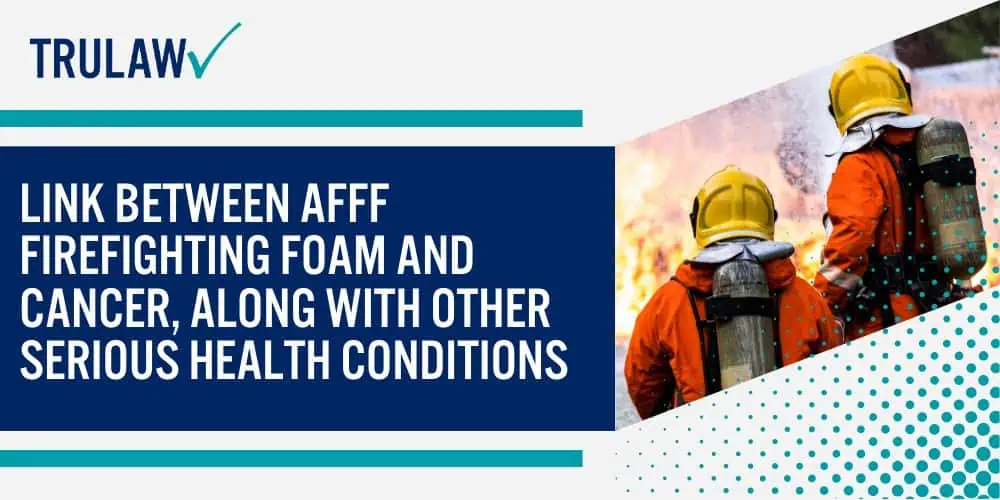
Commonly found in settings such as military bases, airports, manufacturing plants, and fire stations, AFFF remains a standard tool in many industrial and public safety environments.
However, recent research has shown a concerning link between the toxic chemicals present in AFFF and the development of cancer and other serious health conditions.
The chemicals used in some AFFF products, particularly fluorosurfactants, have been identified as potential carcinogens and toxicants.
These substances pose significant human health risks, leading to growing concerns about long-term exposure to AFFF.
What Is an Aqueous Film-Forming Foam (AFFF)?
Aqueous film-forming foam (AFFF), also known as Class B firefighting foam, is a combination of water, fluorochemical surfactants, foam stabilizers, and other additives.
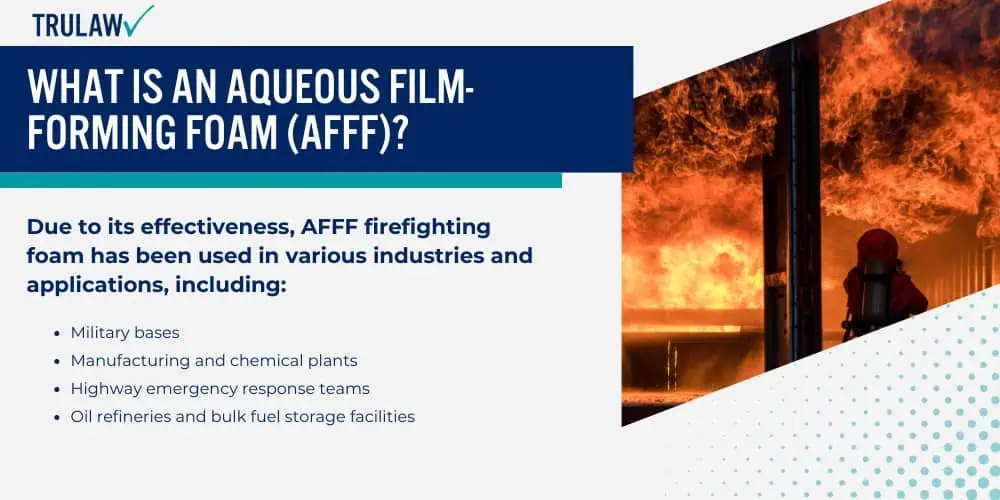
When applied to a flammable liquid fire, AFFF forms a thin film on the surface of the liquid, effectively suppressing the fire by creating a barrier between the fuel and oxygen.
This film not only extinguishes the fire but also acts as a cooling layer, helping to prevent re-ignition.
Due to its effectiveness, AFFF firefighting foam has been used in various industries and applications, including:
- Military bases
- Manufacturing and chemical plants
- Highway emergency response teams
- Oil refineries and bulk fuel storage facilities
- Airports
- Fire departments
- Oil tankers and offshore platforms
- Flammable liquid storage and processing sites
While AFFF has been a trusted tool in fire safety for decades, many AFFF products contain chemicals that pose potential health risks.
These concerns have led to growing scrutiny of its use in recent years.
Composition of AFFF: The Role of Fluorosurfactants (PFAS Chemicals)
Certain brands of Aqueous Film-Forming Foam (AFFF) contain per- and polyfluoroalkyl substances (PFAS), a group of synthetic chemicals valued for their resistance to water, heat, chemicals, and friction.
These properties make PFAS chemicals effective in firefighting foams, as they aid in quickly suppressing flammable liquid fires.
Fluorosurfactants, a specific type of PFAS, are often used in AFFF to enhance the foam’s ability to spread across the surface of a fire, effectively lowering surface tension and increasing fire suppression.
However, certain fluorosurfactants, like perfluorooctane sulfonate (PFOS) and perfluorooctanoic acid (PFOA), have raised considerable concerns due to their persistence in the environment and potential human health risks.
Both the Centers for Disease Control and Prevention (CDC) and the Environmental Protection Agency (EPA) have issued warnings about the potential dangers of PFAS exposure.
Due to their widespread use, PFAS chemicals have been detected in the environment, including soil, air, drinking water, and even in fish and food sources.
The EPA has also reported that traces of these chemicals can be found in the blood samples of both humans and animals, raising additional concerns.
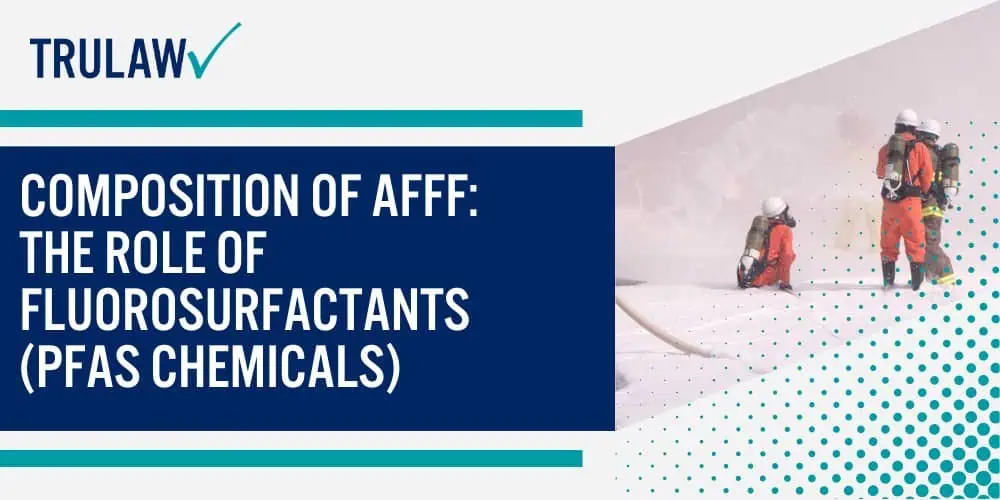
Furthermore, the Agency for Toxic Substances and Disease Registry (ATSDR) has highlighted the potential impact of PFAS on the immune system, signaling a need for caution.
In response, several government agencies have launched studies to assess and reduce the health risks of AFFF exposure.
While research is ongoing to fully grasp the effects of PFAS chemicals, the efforts of governmental and environmental agencies have helped bring greater awareness to the potential hazards linked to AFFF exposure and PFAS contamination.
Symptoms of AFFF Exposure
Exposure to Aqueous Film-Forming Foam (AFFF) or the PFAS chemicals within it can occur through inhalation, ingestion, or skin contact, potentially leading to a variety of health issues.
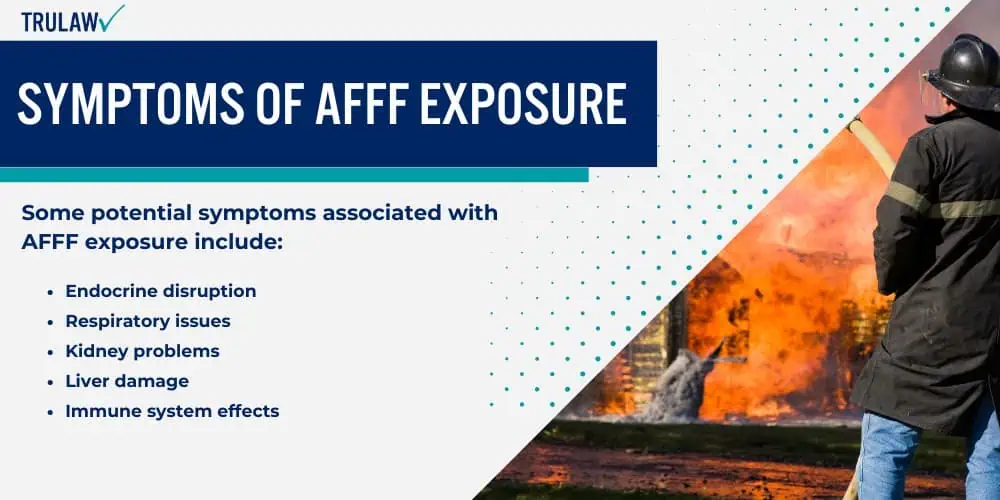
The severity and nature of symptoms often depend on the duration and level of exposure.
Some potential symptoms associated with AFFF exposure include:
- Endocrine disruption: PFAS chemicals can interfere with hormone regulation, potentially leading to hormonal imbalances, reproductive issues, or developmental challenges.
- Respiratory issues: Inhalation of AFFF foam or PFAS chemicals may result in coughing, wheezing, shortness of breath, or chest tightness.
- Kidney problems: Studies suggest that PFAS exposure could impact kidney function, potentially causing symptoms like reduced urine output, swelling in the legs or ankles, and general fatigue.
- Liver damage: Prolonged exposure to PFAS has been linked to liver toxicity, which can manifest as jaundice (yellowing of the skin or eyes), fatigue, and abdominal pain.
- Immune system effects: Some evidence indicates that PFAS exposure may weaken the immune system, making individuals more prone to infections and illnesses.
- Skin reactions: Exposure to AFFF or PFAS may cause skin irritation, redness, itching, or the development of a rash.
- Gastrointestinal discomfort: Individuals exposed to AFFF may experience symptoms such as stomach pain, nausea, vomiting, or diarrhea.
- Eye irritation: Contact with firefighting foam can lead to redness, dryness, itching, tearing, or even eye pain.
If you have been exposed to AFFF or PFAS-containing firefighting foam and experience any of these symptoms, it is important to seek medical attention promptly and consult with a healthcare professional.
Types of Cancer Associated with AFFF Exposure
Several organizations, including the National Cancer Institute’s Division of Cancer Epidemiology and Genetics (DCEG), have conducted research linking regular exposure to firefighting foam with an increased risk of various cancers.
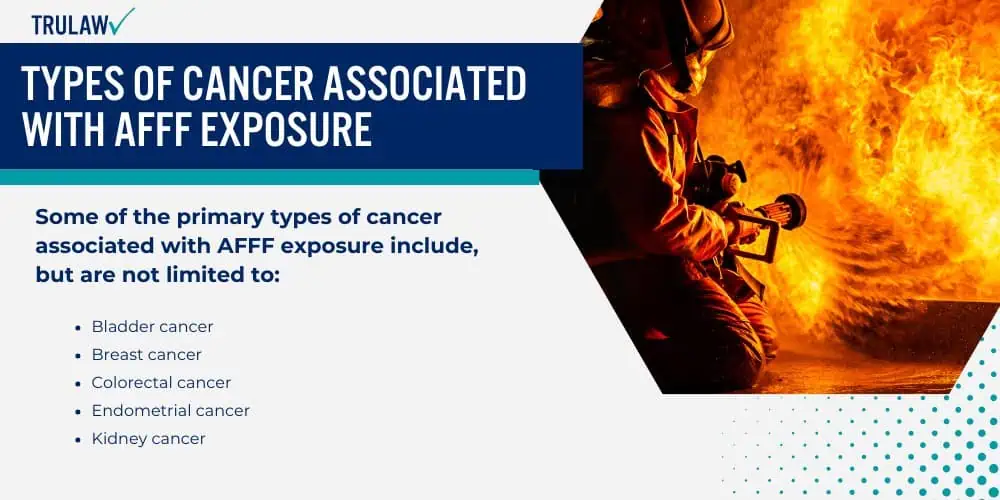
Below, we highlight some of the primary types of cancer associated with AFFF exposure, which include but are not limited to:
- Bladder cancer
- Breast cancer
- Colorectal cancer
- Endometrial cancer
- Kidney cancer
- Leukemia
- Liver cancer
- Lymphoma
- Mesothelioma
- Multiple Myeloma
- Non-Hodgkin Lymphoma
- Ovarian cancer
- Pancreatic cancer
- Prostate cancer
- Testicular cancer
- Thyroid cancer
Bladder Cancer
Studies have shown a higher incidence of bladder cancer in individuals exposed to AFFF.
Toxic chemicals in AFFF can enter the bloodstream and accumulate in the bladder, potentially leading to the development of cancerous cells.
This risk is particularly prevalent in areas with contaminated drinking water due to AFFF runoff.
Colorectal Cancer
Exposure to AFFF has also been associated with an increased risk of colorectal cancer.
The chemicals in AFFF may affect the lining of the colon and rectum, leading to cancerous tumors.
PFAS exposure is believed to contribute to the development of both colon and rectal cancers.
Kidney Cancer
Research suggests a potential link between AFFF exposure and kidney cancer.
The chemicals in AFFF, particularly perfluorooctanoic acid (PFOA), can be filtered by the kidneys, potentially causing damage and increasing the risk of cancer.
PFOA has been identified as a likely renal carcinogen.
Liver Cancer
AFFF exposure has been connected to an elevated risk of liver cancer.
The liver is responsible for detoxifying chemicals in the body, and prolonged exposure to AFFF can cause liver damage and inflammation, potentially leading to the development of cancerous cells.
Studies indicate that PFAS exposure increases the risk of certain types of liver cancer.
Testicular Cancer
There is a noted increase in testicular cancer among individuals exposed to AFFF.
The chemicals in AFFF may disrupt hormone levels, affecting the reproductive system and leading to a higher risk of testicular cancer.
Research has shown a correlation between elevated PFOA levels and the incidence of this cancer.
Prostate Cancer
AFFF exposure has been linked to an increased risk of prostate cancer.
The toxic chemicals in firefighting foam can interfere with hormone regulation, potentially resulting in cancerous growths in the prostate gland.
Populations exposed to PFAS-containing foam have shown a higher incidence of prostate cancer.
Pancreatic Cancer
Emerging evidence suggests a possible connection between AFFF exposure and pancreatic cancer.
The harmful chemicals in AFFF may negatively affect the pancreas, leading to the development of cancerous tumors.
Studies indicate a higher occurrence of pancreatic cancer in individuals with known PFAS exposure.
Additional Health Issues Tied to Toxic Firefighting Foam Exposure
In addition to an increased risk of cancer, research has shown that AFFF exposure may also contribute to several non-cancerous health conditions.
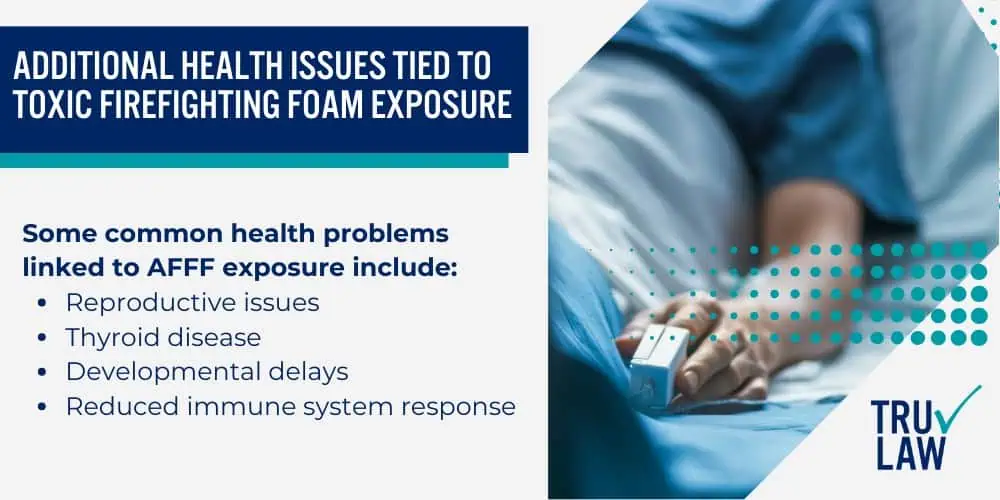
Some common health problems linked to AFFF exposure include:
- Reproductive issues
- Thyroid disease
- Developmental delays
- Reduced immune system response
These findings highlight the serious health risks associated with toxic firefighting foam exposure, underscoring the importance of exploring legal options for those affected.
Occupations at Higher Risk of AFFF Exposure
Occupational exposure is one of the most common ways people come into contact with toxic firefighting foam.
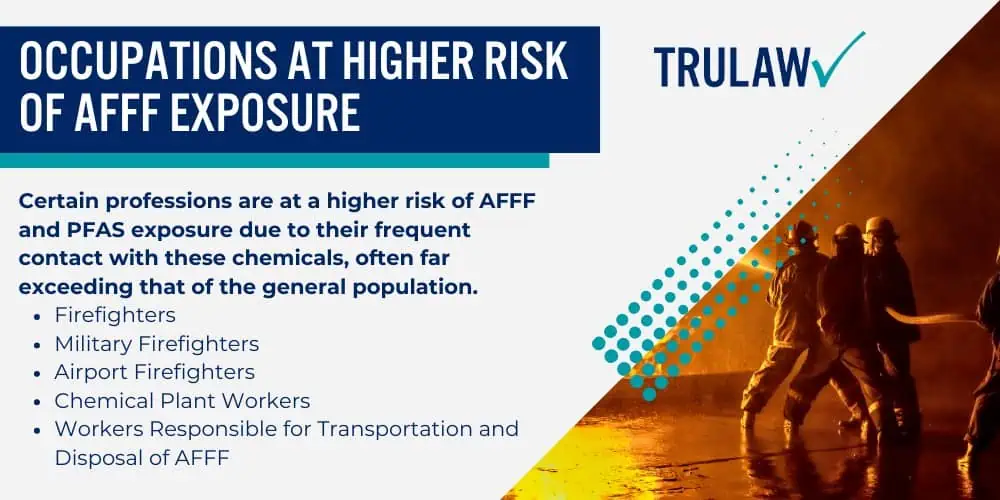
Certain professions are at a higher risk of AFFF and PFAS exposure due to their frequent contact with these chemicals, often far exceeding that of the general population.
Firefighters
Firefighters are among the most at risk for exposure to toxic firefighting foam.
In their daily work, firefighters may come into contact with large amounts of AFFF, and even after use, the foam’s residue can remain on their gear, clothing, and equipment.
Over time, repeated exposure increases their chances of developing health problems linked to PFAS.
Military Firefighters
Military firefighters—serving in branches like the Navy, Air Force, and Army—regularly use AFFF to put out fires.
This repeated use during training exercises and actual emergencies puts them at a higher risk of exposure.
As AFFF has been commonly used in the military for decades, these individuals may face health risks related to the foam’s chemical components.
Airport Firefighters
Airport firefighters also face heightened exposure due to the frequent use of AFFF in response to aircraft fires.
The foam was used to combat highly flammable materials found in aviation, but it poses a risk to the health of those using it.
Additionally, others working near AFFF, like air traffic controllers and aircraft technicians, may also be exposed to dangerous levels of PFAS over time.
Chemical Plant Workers
Employees in chemical plants or facilities where flammable liquids are produced or stored often come into contact with AFFF.
Workers in these environments face a heightened risk of exposure to AFFF and its related health concerns, as the foam is used in these facilities for fire prevention and suppression.
Workers Responsible for Transportation and Disposal of AFFF
Those tasked with transporting or disposing of AFFF are also at risk.
Without strict adherence to proper handling procedures, they may encounter harmful levels of PFAS.
This risk extends to individuals working for firefighting foam manufacturers, suppliers, and contractors who come into regular contact with the foam during their duties.
Do You Qualify for the AFFF Lawsuit?
AFFF firefighting foam lawsuits are focused on holding manufacturers and suppliers accountable for the production and distribution of AFFF products.
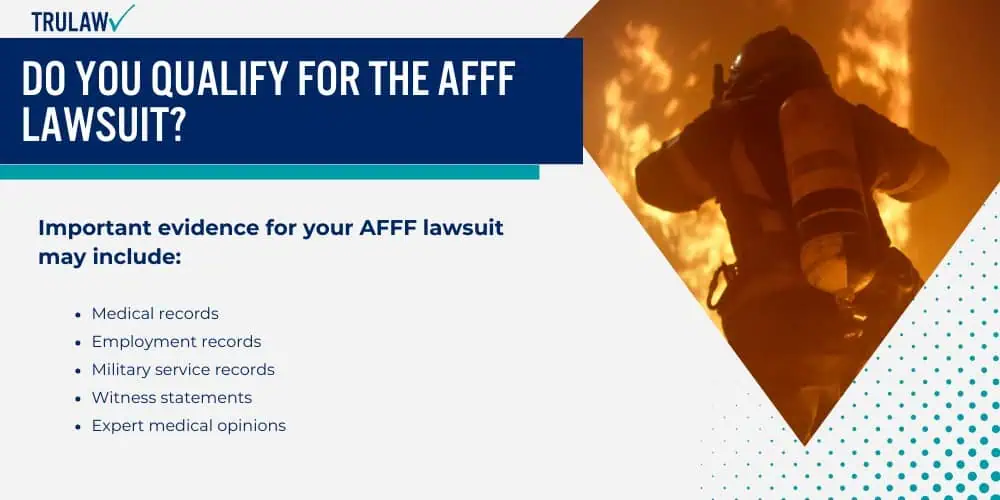
These companies may be responsible for negligence, failing to provide proper warnings, and misrepresenting the safety of their products.
Several major manufacturers, including 3M, DuPont, and Tyco Fire Products, have already been named in lawsuits for their role in producing hazardous firefighting foam.
If you have been exposed to AFFF and later developed cancer or other related health issues, you may qualify to file an AFFF lawsuit.
It’s important to understand your rights and the legal avenues available to you — TruLaw is here to help ensure your interests are protected.
Collecting Evidence for AFFF Lawsuits
Evidence plays a large role in building a strong case for AFFF exposure and related health problems.
While your legal team will assist in collecting the necessary documentation, clients can also contribute by organizing key records.
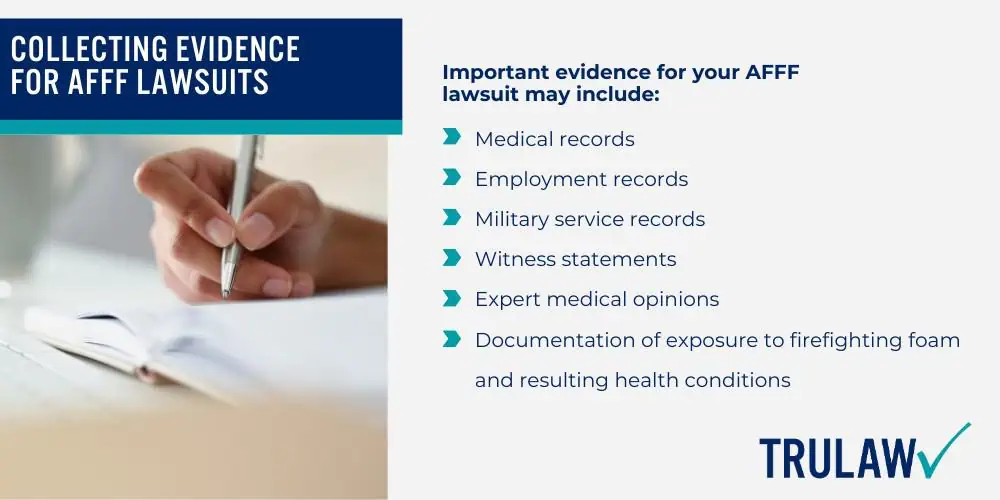
Important evidence for your AFFF lawsuit may include:
- Medical records
- Employment records
- Military service records
- Witness statements
- Expert medical opinions
- Documentation of exposure to firefighting foam and resulting health conditions
An AFFF lawsuit can be overwhelming, but TruLaw can help guide you through each step of the process, ensuring you have the necessary support throughout your claim.
Assessing Damages for AFFF Firefighting Foam Lawsuits
Damages refer to the total losses, both financial and non-financial, that arise from exposure to firefighting foam and the subsequent health complications.
These damages will be calculated as part of determining the potential settlement amount for your AFFF lawsuit.
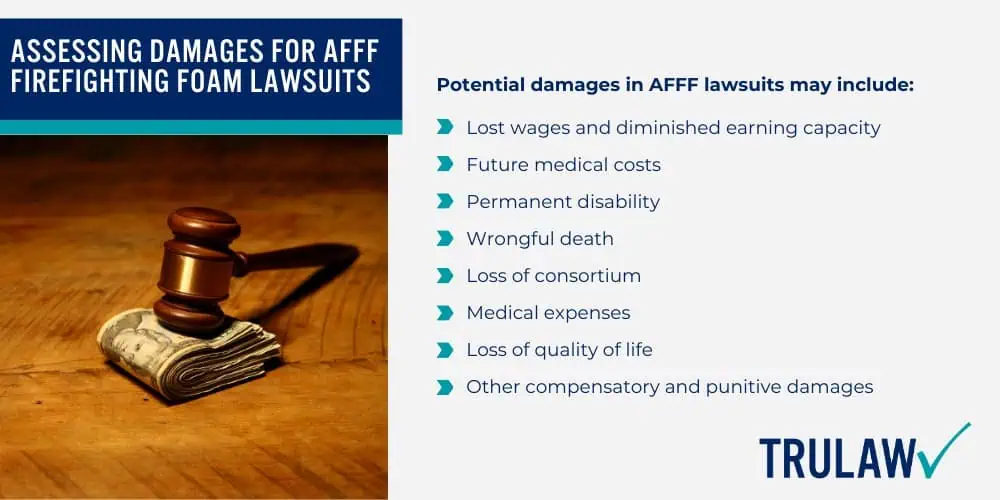
Potential damages in AFFF lawsuits may include:
- Lost wages and diminished earning capacity
- Future medical costs
- Permanent disability
- Wrongful death
- Loss of consortium
- Medical expenses
- Loss of quality of life
- Other compensatory and punitive damages
Calculating these damages is a key factor in determining any settlement that may result from your claim.
Your legal team will work diligently to ensure you seek fair compensation for the losses you’ve experienced.
TruLaw: Your Firefighting Foam Law Firm
The AFFF lawyers at TruLaw and our partner law firms are currently accepting firefighting foam cancer claims and assessing potential eligibility for AFFF litigation.
We understand the impact that exposure to harmful products, such as firefighting foam, can have on the lives of workers, military and airport firefighters, civilian firefighters, and others who may have come into contact with AFFF.
If you have been exposed to AFFF and developed cancer or other related illnesses, you may be eligible to file an AFFF cancer lawsuit.
You can use the chatbot on this page to instantly determine if you qualify for an AFFF lawsuit.
We collaborate with AFFF litigation leaders to connect you with toxic exposure lawyers with experienced suited to your claim.
AFFF Lawsuit Frequently Asked Questions
-
Is there an AFFF class action lawsuit?
No, there is not an AFFF class action lawsuit for cancer and other injuries resulting from exposure to firefighting foam.
Instead, AFFF lawsuits have been consolidated into multidistrict litigation (MDL).
The AFFF firefighting foam MDL brings all AFFF lawsuits together under one US District Court to ensure consistent rulings and more efficient legal proceedings.
When many individuals are affected by the same issue, the federal court system often uses an MDL to manage litigation, reduce costs, and expedite the process.
Currently, the AFFF MDL is centralized in the US District Court for the District of South Carolina.
-
What is the average firefighting foam lawsuit settlement amount?
The settlement amount for an AFFF firefighting foam lawsuit can vary based on several factors.
A successful claim typically includes evidence detailing the exposure to firefighting foam, medical bills and records documenting treatment, and other relevant details to support the case.
These factors will play an important role in determining the settlement value for any given AFFF lawsuit.
While no settlements have been reached in the AFFF litigation so far, attorneys estimate that potential settlement amounts could range between $20,000 to $600,000 or more, depending on the specific case and individual factors.
These projections are not guaranteed outcomes but are based on knowledge of prior mass tort cases and settlements involving cancer diagnoses.
-
Do I qualify for the AFFF cancer lawsuit?
If you or a loved one were exposed to firefighting foam and developed cancer afterward, you may qualify to file a firefighting foam cancer lawsuit.
Reach out to TruLaw for a free consultation to discuss your eligibility.
You can use the chatbot on this page to instantly find out if you qualify to join others in filing an AFFF lawsuit.

Managing Attorney & Owner
With over 25 years of legal experience, Jessica Paluch-Hoerman is an Illinois lawyer, a CPA, and a mother of three. She spent the first decade of her career working as an international tax attorney at Deloitte.
In 2009, Jessie co-founded her own law firm with her husband – which has scaled to over 30 employees since its conception.
In 2016, Jessie founded TruLaw, which allows her to collaborate with attorneys and legal experts across the United States on a daily basis. This hypervaluable network of experts is what enables her to share the most reliable, accurate, and up-to-date legal information with our readers!
Additional AFFF Lawsuit resources on our website:
Here, at TruLaw, we’re committed to helping victims get the justice they deserve.
Alongside our partner law firms, we have successfully collected over $3 Billion in verdicts and settlements on behalf of injured individuals.
Would you like our help?
At TruLaw, we fiercely combat corporations that endanger individuals’ well-being. If you’ve suffered injuries and believe these well-funded entities should be held accountable, we’re here for you.
With TruLaw, you gain access to successful and seasoned lawyers who maximize your chances of success. Our lawyers invest in you—they do not receive a dime until your lawsuit reaches a successful resolution!
AFFF Lawsuit claims are being filed against manufacturers of aqueous film-forming foam (AFFF), commonly used in firefighting.
Claims allege that companies such as 3M, DuPont, and Tyco Fire Products failed to adequately warn users about the potential dangers of AFFF exposure — including increased risks of various cancers and diseases.
Depo Provera Lawsuit claims are being filed by individuals who allege they developed meningioma (a type of brain tumor) after receiving Depo-Provera birth control injections.
A 2024 study found that women using Depo-Provera for at least 1 year are five times more likely to develop meningioma brain tumors compared to those not using the drug.
Suboxone Tooth Decay Lawsuit claims are being filed against Indivior, the manufacturer of Suboxone, a medication used to treat opioid addiction.
Claims allege that Indivior failed to adequately warn users about the potential dangers of severe tooth decay and dental injuries associated with Suboxone’s sublingual film version.
Social Media Harm Lawsuits are being filed against social media companies for allegedly causing mental health issues in children and teens.
Claims allege that companies like Meta, Google, ByteDance, and Snap designed addictive platforms that led to anxiety, depression, and other mental health issues without adequately warning users or parents.
Transvaginal Mesh Lawsuits are being filed against manufacturers of transvaginal mesh products used to treat pelvic organ prolapse (POP) and stress urinary incontinence (SUI).
Claims allege that companies like Ethicon, C.R. Bard, and Boston Scientific failed to adequately warn about potential dangers — including erosion, pain, and infection.
Bair Hugger Warming Blanket Lawsuits involve claims against 3M — alleging their surgical warming blankets caused severe infections and complications (particularly in hip and knee replacement surgeries).
Plaintiffs claim 3M failed to warn about potential risks — despite knowing about increased risk of deep joint infections since 2011.
Baby Formula NEC Lawsuit claims are being filed against manufacturers of cow’s milk-based baby formula products.
Claims allege that companies like Abbott Laboratories (Similac) and Mead Johnson & Company (Enfamil) failed to warn about the increased risk of necrotizing enterocolitis (NEC) in premature infants.
Here, at TruLaw, we’re committed to helping victims get the justice they deserve.
Alongside our partner law firms, we have successfully collected over $3 Billion in verdicts and settlements on behalf of injured individuals.
Would you like our help?
